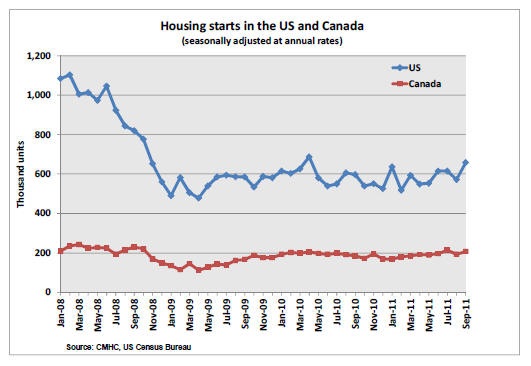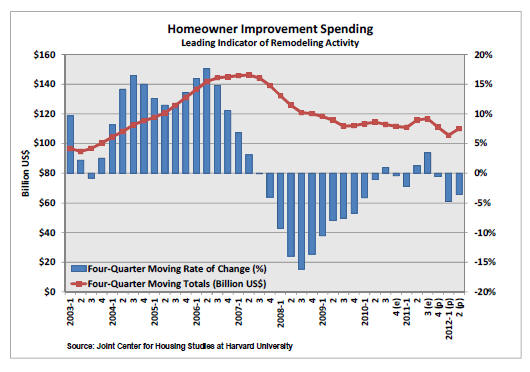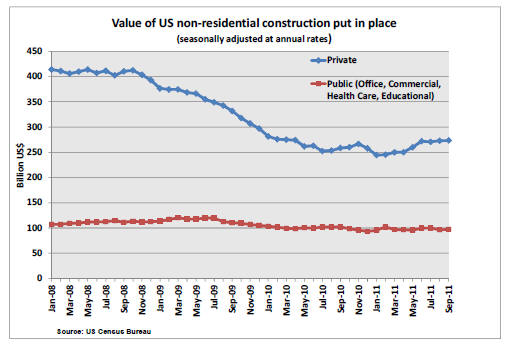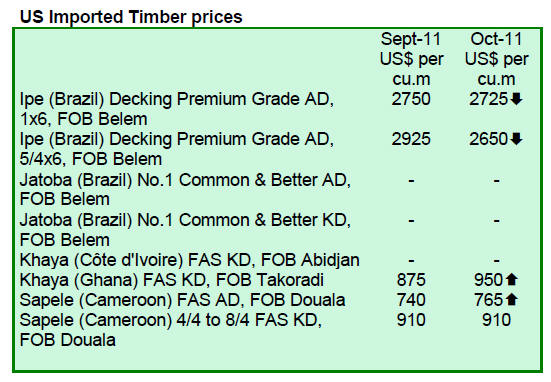|
Report
from
North America
Canada¡¯s economy still strong but risks are growing
Although there is considerable economic uncertainty,
especially with regards to the sovereign debt crisis in
Europe and the US economic weakness, Canada has
continued to show relatively good employment figures and
a high level of immigration, which support investment in
residential construction.
Mortgage rates remain at historically low levels with the
central bank¡¯s key interest rate at 1%.
The weakness in the world¡¯s two largest economies (the
euro zone and the US) and the prospect of a slowdown in
economic growth in China will have implications for
Canada.
Large forest product companies are completing their
planned capital expenditure projects, but they are holding
back on larger investments, according to a Vancouver Sun
article. Canada¡¯s central bank has reduced its GDP growth
forecast for 2012 to 1.9% from 2.6%. In 2010, Canada¡¯s
economy grew 3.2%.
Employment declined in October, pushing up the
unemployment rate to 7.3%. Compared to the same time
last year, however, total employment has risen by 1.4%
and the unemployment rate is more than two percentage
points lower than at the height of the recession in 2009.
Canada¡¯s real GDP grew by 0.3% in August, following
increases of 0.4% in July and 0.2% in June, according to
Statistics Canada. Excluding Canada¡¯s significant energy
sector, however, GDP remained unchanged. Oil and gas
extraction rose and with it the industries that support
drilling and rigging.
Canadian housing market remains steady
Canada¡¯s seasonally adjusted annual rate of housing starts
was 207,600 in October, down from 208,800 in October.
The latest Canada Mortgage and Housing Corporation
(CMHC) figures show that single-family starts have
declined while construction of apartment buildings and
townhouses is still strong.
2011 housing starts are forecast to be 191,000, up from
189,930 in 2010. CMHC expects residential construction
to moderate next year with starts possibly below 2010
levels.
Investment in non-residential building construction
decreased by 1.3% in the third quarter of 2011, but the
commercial building construction segment was slightly up
(+0.4%), according to Statistics Canada.
Commercial construction includes office and retail
buildings where wood use is higher than in other nonresidential
buildings. The value of permits for nonresidential
building construction fell by 11 % in
September, the third consecutive monthly decline.
Positive signals in the US housing market
The latest US housing market data is finally looking more
positive for wood product manufacturers and home
builders. Housing starts in September were 658,000
(seasonally adjusted annual rate), up by 15% from August
and 10.2% above the September 2010 rate, according to
the US Department of Commerce.
Sales of new single-family homes also did well in
September; sales increased by 5.7% from the previous
month. First-time home buyers are driving the market
according to the National Association of Home Builders,
and potential changes to federal programs supporting
homeownership could threaten this recovery.
Building permits for new homes fell to a seasonally
adjusted annual rate of 594,000 units in September, but the
rate remains above September 2010 levels. The number of
permits issued can be an indicator of future building
activity.
The National Association of Home Builders reports that
builder confidence in the market for new single-family
homes increased in October, the largest gain since the
home buyer tax credit program boosted demand in April
2010. Price pressure from foreclosed home sales and tight
lending conditions continue to limit the market for new
housing in most regions.

Home improvement spending expected to decline
Spending on home repair and remodelling in the US is
expected to decline further over the last quarter of 2011
and the first quarter of 2012, according to forecasts by the
Harvard Joint Center for Housing Studies. This comes
after weakening expenditures in the first half of 2011.
Homeowners undertake smaller renovation projects, but
they are postponing larger investments due to the
economic uncertainty. A significant upturn in repair and
remodelling activities is unlikely until sales of existing
homes pick up.

No significant change in US non-residential building construction
The latest construction spending data from the US
Department of Commerce shows that non-residential
construction improved by 0.5% from August to
September. The value of private construction increased
slightly (+0.3%), while public building construction went
up by 1.2% because of increased spending in the education
sector.
Commercial and industrial architecture firms reported
significant improvements in business conditions in
September following a brief downturn in August. All other
sectors (institutional, mixed and residential) report a
decline in the firms¡¯ billings.
New project inquiries were low in September. Regional
differences are large; firms in the Northeast and Midwest
report improving conditions, while the South and West
saw declines.

American hardwoods promotion campaign goes online
The promotional campaign for American hardwoods has a
web portal, www.HardwoodInfo.com. The American
Hardwood Information Center provides consumers with
design, trend and other information related to American
hardwood products.
The site was originally set up the Hardwood
Manufacturers Association, but serves now for the
campaign as well, providing member companies with
marketing and sales tools to promote American hardwood
products.
Online building cost calculator for architects and engineers
A new online calculator allows architects, engineers and
other users to compare the cost of construction of
buildings or shells using different materials. The calculator
was released by WoodWorks, a US-Canadian co-operation
of wood associations and government agencies that
promotes wood use in non-residential and multi-family
buildings.
The calculator allows users to compare the cost of
constructing a specific building type in different materials,
such as wood or steel. Wood construction is often less
costly than other materials because of lower material cost
or shorter construction time.
WoodWorks is also planning to provide a carbon
calculator that shows the amount of carbon stored in wood
buildings and the greenhouse gas emissions avoided if
using wood instead of concrete or steel. The calculators
are available at woodworks.org

Related News:
|